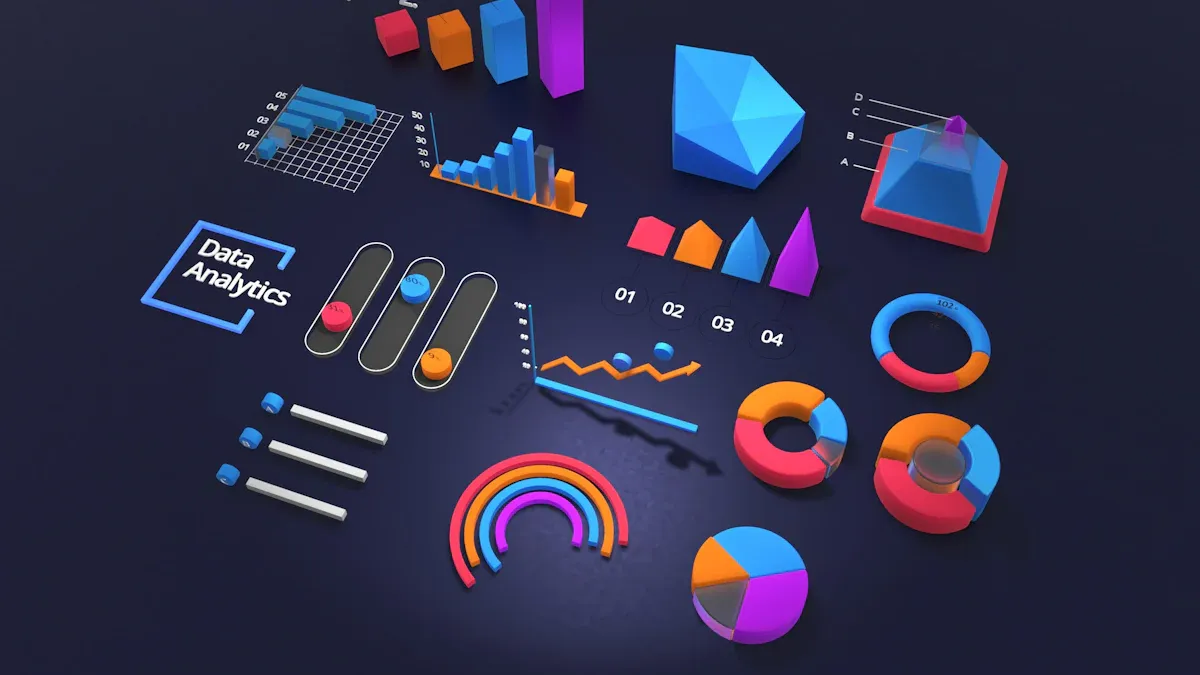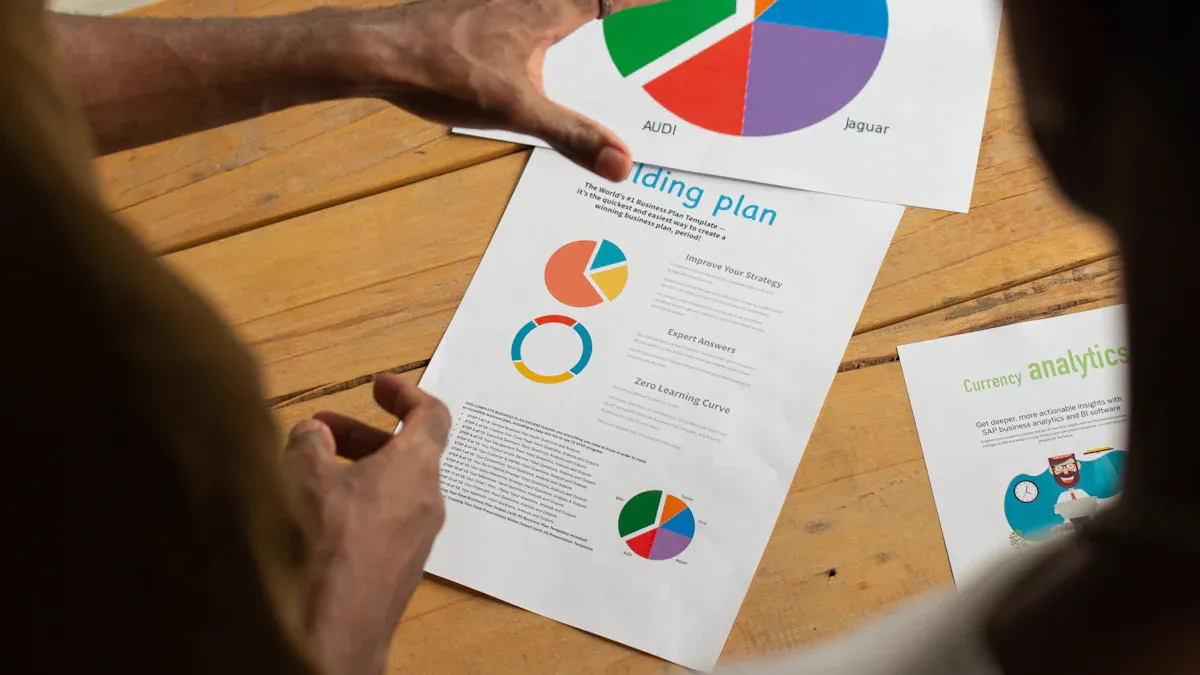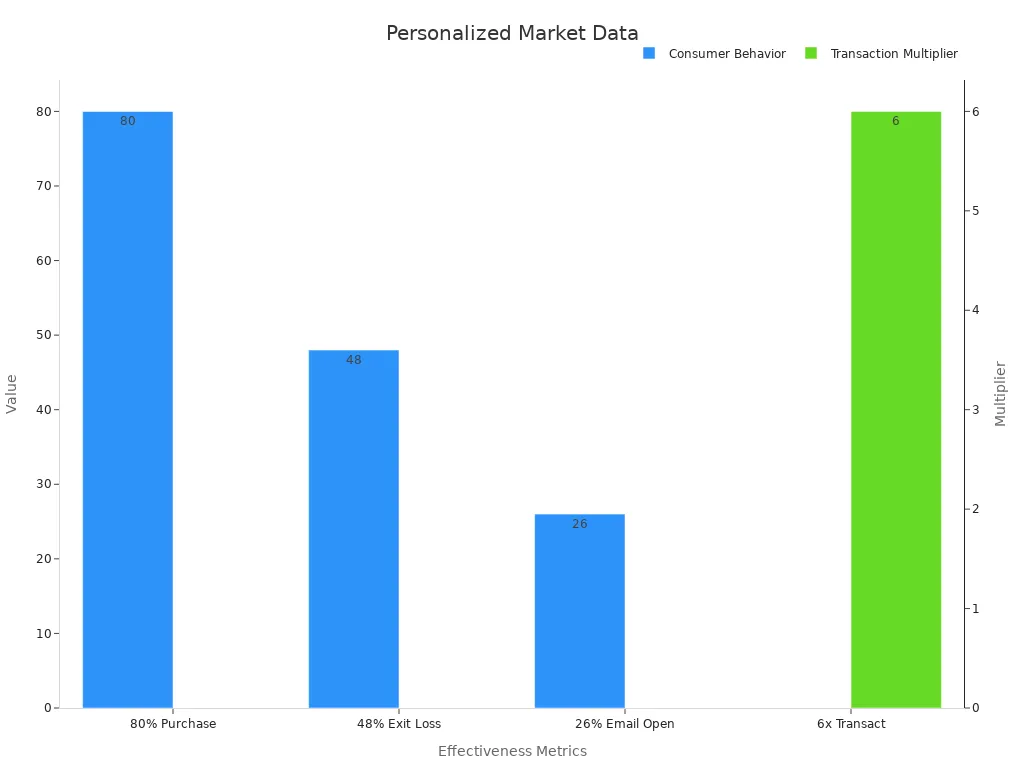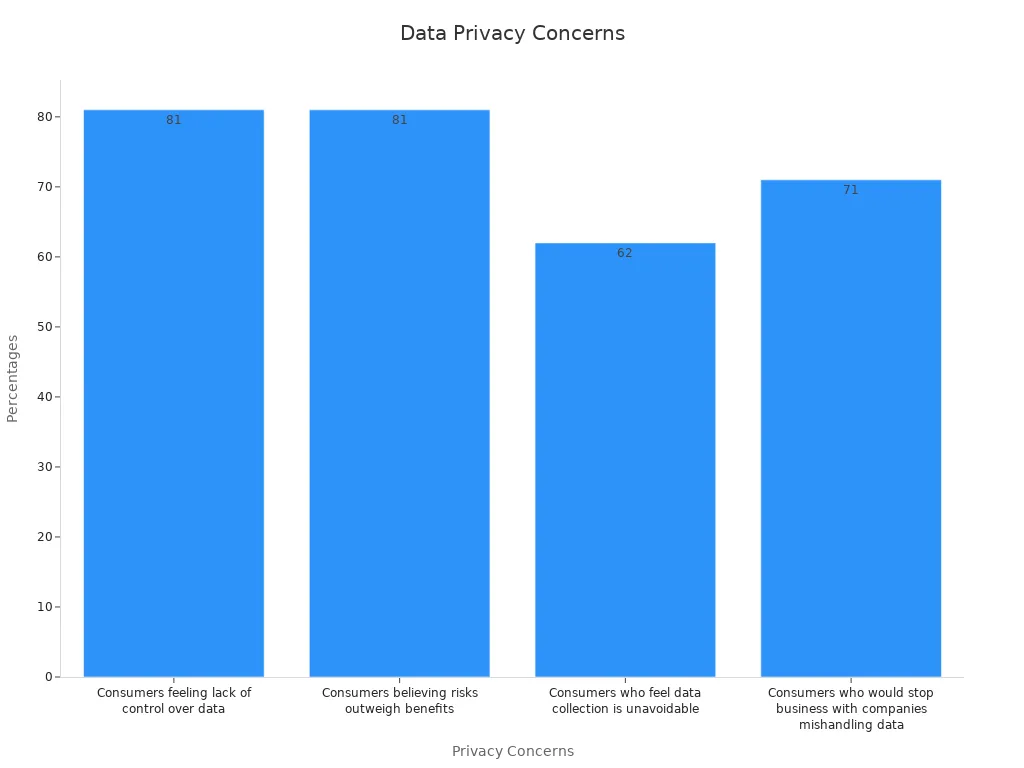Turning Consumer Behavior Analysis into Business Interventions

Understanding what drives your customers' decisions can transform how you approach business strategies. Consumer Behavior Analysis helps you uncover what your audience values, how they shop, and what influences their choices. For example:
Personalized marketing can boost conversion rates by up to 50%, proving the value of tailored experiences.
Around 55% of customers are willing to pay more for brands that prioritize sustainability and ethics.
By analyzing these behaviors, you can refine your marketing, develop products that resonate, and build stronger connections with your audience.
Key Takeaways
Learning how customers act helps businesses create better plans for them.
Custom marketing can increase interest and sales, which is key today.
Gathering and grouping data are important for making smart business plans.
Using customer insights improves experiences, making people happier and loyal.
Updating plans often based on customer actions keeps them useful and strong.
Importance of Consumer Behavior Analysis

Understanding consumer behavior is essential for businesses aiming to stay competitive in today’s dynamic market. By analyzing how customers interact with products and services, you can uncover valuable insights that drive better decision-making. Let’s explore three key aspects of why Consumer Behavior Analysis matters.
Identifying Trends and Patterns
Consumer behavior often reveals trends that shape industries. For instance, many companies now focus on sustainability because customers increasingly prefer brands with ethical practices. By identifying patterns like these, you can align your strategies with what matters most to your audience.
Why trends matter:
They help you anticipate shifts in customer preferences.
They guide innovation and product development.
Trend | Description |
|---|---|
Businesses use data to create marketing strategies that resonate with individual consumers. | |
Digital Influence | Social media and online reviews significantly impact purchasing decisions. |
Sustainability and Ethical Consumption | Customers favor brands that demonstrate responsibility toward the environment and society. |
When you recognize these patterns, you can position your business to meet customer expectations effectively.
Predicting Future Behavior
Predicting what your customers will do next gives you a competitive edge. Tools like regression analysis and machine learning allow you to forecast purchasing trends with remarkable accuracy. For example, time series forecasting can identify seasonal buying habits, helping you prepare inventory or launch timely promotions.
Predictive Model | Description |
|---|---|
Regression Analysis | Understands relationships between variables affecting purchasing decisions. |
Machine Learning (ML) | Identifies patterns in data to predict future purchases. |
Time Series Forecasting | Analyzes historical data to forecast cyclical consumer behavior. |
Cluster Analysis | Segments customers based on preferences for targeted marketing. |
Neural Networks | Detects complex patterns to predict trends and behaviors. |
By leveraging these models, you can make data-driven decisions that align with your customers’ future needs.
Enhancing Customer Experience
A great customer experience builds loyalty and drives growth. When you understand what your audience values, you can tailor interactions to exceed their expectations. For instance, Amazon’s recommendation system uses Consumer Behavior Analysis to suggest products, contributing to 35% of its revenue. Similarly, Zappos prioritizes customer service, resulting in high retention rates.
Key benefits of enhancing customer experience:
A 15% increase in customer satisfaction scores has been observed with improved strategies.
Personalized experiences foster deeper connections with your audience.
Company | Strategy Description | Impact on Business Outcomes |
|---|---|---|
Coca-Cola | Customized product offerings based on local consumer behaviors and preferences. | Increased brand loyalty and market penetration. |
Netflix | Monitors viewer behavior to tailor content production and acquisition. | Ensures customer retention and growth. |
Amazon | Uses a recommendation system based on consumer behavior analysis. | Contributes to 35% of revenue through upsells and cross-sells. |
Zappos | Focuses on customer service excellence to enhance user experience. | High retention rates and deep brand loyalty. |
When you prioritize customer experience, you not only meet expectations but also create advocates for your brand.
Steps to Turn Consumer Behavior Analysis into Business Interventions
Data Collection and Segmentation
Turning Consumer Behavior Analysis into actionable strategies begins with gathering and organizing data. You need to define clear research objectives to understand what you aim to learn about your customers. Collect data from diverse sources, including surveys, focus groups, and analytics tools, to ensure a comprehensive view of consumer behavior.
Tip: Combine quantitative data, like purchase history, with qualitative insights, such as customer feedback, to create a balanced dataset.
Segmentation is the next critical step. Grouping customers into distinct categories allows you to tailor your strategies effectively. Consider these proven segmentation methods:
Psychographic segmentation: Focus on lifestyle, values, interests, and personality traits to connect with customers on a deeper level.
Behavioral segmentation: Categorize consumers based on their interactions with your products or services to enhance retention.
Market research-driven segmentation: Use surveys and focus groups to identify motivations and preferences that differentiate consumer groups.
When you segment your audience thoughtfully, you can create targeted interventions that resonate with each group’s unique needs.
Insight Generation
Data alone doesn’t drive decisions—it’s the insights you extract that matter. Use analytics tools to identify patterns and trends in consumer behavior. For example, machine learning can uncover hidden relationships in data, while cluster analysis helps you group similar customers for targeted strategies.
Insights play a pivotal role in shaping your business. They enhance product development by identifying customer needs and market gaps. They refine marketing strategies, ensuring campaigns are relevant and resource-efficient. Insights also improve customer support, fostering loyalty through better post-purchase experiences.
Note: Regularly revisit your insights to adapt to changing consumer preferences. This ensures your strategies remain effective over time.
Strategy Formulation
Once you’ve generated actionable insights, it’s time to translate them into business plans. Start by defining your vision and mission to align your strategies with overarching goals. Conduct a situation analysis to understand your current position in the market.
Set clear strategic objectives based on your insights. For example, if your analysis reveals a growing demand for eco-friendly products, prioritize sustainability in your offerings. Identify key resources and capabilities to support your goals, and develop competitive strategy options that leverage your strengths.
Finally, formulate detailed action plans. Break down your strategies into specific tasks, assign responsibilities, and establish timelines. Implement these plans and monitor their performance to ensure they meet customer needs effectively.
Callout: Strategy formulation is not a one-time process. Continuously refine your plans based on feedback and evolving consumer behavior.
Implementation
Turning insights into action is where the real impact of Consumer Behavior Analysis begins. Implementation bridges the gap between strategy and results. It ensures that your business interventions align with customer needs and deliver measurable outcomes. Here’s how you can effectively implement strategies derived from consumer insights.
1. Develop Clear Action Plans
Start by breaking down your strategy into actionable steps. Assign specific tasks to team members and set realistic deadlines. For example, if your analysis highlights a demand for personalized marketing, outline the tools and resources needed to create tailored campaigns. Use project management software to track progress and ensure accountability.
Tip: Keep your action plans flexible. Consumer preferences can change, and your strategies should adapt accordingly.
2. Leverage Technology for Execution
Technology plays a crucial role in implementing consumer-focused strategies. Use customer relationship management (CRM) systems to automate personalized communications. Employ data analytics tools to monitor the effectiveness of your interventions in real time. For instance, online streaming platforms use algorithms to recommend content based on viewer habits, leading to higher engagement rates.
3. Monitor and Measure Success
Tracking the performance of your interventions is essential. Define key performance indicators (KPIs) that align with your goals. For example, if your strategy involves offering tailored promotions, measure metrics like repeat purchases and customer satisfaction. Regularly review these metrics to identify areas for improvement.
Industry | Strategy Description | Success Metrics |
|---|---|---|
Hotel Chain | Tailored promotional offers based on guests' previous preferences | 15% increase in repeat bookings, 25% rise in guest satisfaction |
Credit Card Company | Targeted rewards based on transaction data | 30% increase in card usage, improved customer loyalty |
Online Streaming | Personalized content recommendations based on viewer habits | 40% increase in engagement, 20% reduction in cancellations |
Car Manufacturer | Customized maintenance plans from data analysis of connected vehicles | 50% increase in customer satisfaction, 35% uptick in loyalty |
4. Foster Collaboration Across Teams
Successful implementation requires collaboration. Encourage open communication between marketing, sales, and customer service teams. Share insights from Consumer Behavior Analysis to ensure everyone works toward the same objectives. For example, when launching a new product, involve all departments to align messaging and delivery.
5. Iterate and Improve
Implementation is not a one-time process. Continuously gather feedback from customers and analyze new data to refine your strategies. This iterative approach ensures your interventions remain relevant and effective over time.
Callout: Businesses that regularly update their strategies based on consumer insights see higher customer satisfaction and loyalty.
By following these steps, you can turn insights into impactful actions that drive growth and enhance customer experiences.
Examples of Successful Business Interventions

Personalized Marketing Campaigns
Personalized marketing campaigns have revolutionized how businesses connect with their customers. By tailoring messages and offers to individual preferences, you can significantly improve engagement and conversion rates. For instance, 80% of consumers are more likely to make a purchase when they experience personalization. On the other hand, 48% of customers leave websites due to poorly curated experiences.
Statistic | Source |
|---|---|
80% of consumers are more likely to make a purchase with personalized experiences. | |
Personalized emails have 26% higher open rates. | |
Personalized email campaigns can generate six times higher transaction rates. |
You can use tools like customer relationship management (CRM) systems to automate personalized emails or recommend products based on browsing history. These strategies not only boost sales but also enhance customer satisfaction.
Product Development Based on Consumer Feedback
Listening to your customers can lead to better products and higher retention rates. Businesses that incorporate consumer feedback into product development see a 65% success rate in product launches. This approach also reduces market research costs by 40%, allowing you to reinvest in other critical areas.
Statistic Description | Impact on Product Development |
|---|---|
25-30% increase in customer retention through responsive feedback | Justifies resource allocation towards feedback-driven strategies |
65% success rate in product launches with customer suggestions | Encourages proactive customer engagement for product enhancements |
40% reduction in market research costs using direct feedback | Enables more frequent research cycles and reinvestment in critical areas |
For example, companies like LEGO actively involve customers in the design process, resulting in products that resonate with their audience. By prioritizing feedback, you can create offerings that meet real needs and build stronger customer loyalty.
Dynamic Pricing Strategies
Dynamic pricing allows you to adjust prices based on demand, competition, and other factors. Companies like Amazon use AI-powered tools to analyze market trends and competitor pricing in real time. This strategy maximizes revenue and ensures competitive pricing.
Offline Experiments: Studies using Alibaba’s datasets show that dynamic pricing outperforms manual pricing in revenue generation.
Online Field Experiments: Platforms like Tmall.com have demonstrated the effectiveness of dynamic pricing for luxury goods and fast-moving consumer goods (FMCGs).

By implementing dynamic pricing, you can stay competitive, optimize profits, and cater to customer expectations effectively.
Challenges in Applying Consumer Behavior Analysis
Understanding consumer behavior can transform your business, but applying these insights comes with challenges. Addressing these obstacles is essential to ensure your strategies succeed.
Data Privacy Concerns
Consumers today are more aware of how their data is collected and used. Many feel uneasy about sharing personal information, especially when they lack control over how it is handled. Studies reveal that 81% of consumers feel they have no control over their data, and the same percentage believe the risks of data collection outweigh the benefits. Additionally, 71% would stop doing business with companies that mishandle their information.
Statistic | Percentage |
|---|---|
Consumers feeling lack of control over data | 81% |
Consumers believing risks outweigh benefits | 81% |
Consumers who feel data collection is unavoidable | 62% |
Consumers who would stop business with companies mishandling data | 71% |

To address these concerns, you must prioritize transparency and ethical practices. Clear communication about how you collect, store, and use data can build trust with your audience.
Misinterpretation of Data
Analyzing consumer behavior requires precision. Misinterpreting data can lead to costly mistakes. For example, Apple faced backlash when it misread feedback about the iPhone 4’s signal issues, resulting in negative reviews. Similarly, Toyota struggled with unintended acceleration issues due to misinterpreted customer feedback. These examples highlight the importance of accurate analysis.
To avoid such pitfalls, focus on selecting appropriate research methods and ensuring data quality. Regularly validate your findings to ensure they align with customer expectations.
Resistance to Change
Even with accurate insights, implementing changes can face resistance within your organization. Employees may hesitate to adopt new strategies due to concerns about fairness or lack of support. Research shows that perceptions of organizational justice play a significant role in reducing resistance. Providing clear communication and fostering collaboration can help ease transitions.
Tip: Engage your team early in the process. When employees feel involved, they are more likely to embrace change and contribute to its success.
By addressing these challenges, you can effectively apply consumer behavior analysis to drive meaningful business outcomes.
Solutions to Overcome Challenges
Addressing Data Privacy Concerns
Data privacy is a growing concern for consumers. To address this, you need to adopt ethical and transparent practices. Start by continuously monitoring your data collection and usage to ensure compliance with privacy standards. Regular reviews help you identify and fix potential issues before they escalate.
Involving stakeholders, such as customers and employees, in discussions about data ethics builds trust. When people feel included, they are more likely to support your efforts. Promoting ethical leadership across your organization also reinforces a culture that prioritizes privacy and fairness.
Here are some actionable steps you can take:
Invest in first-party data collection to gather information directly from customers.
Use Customer Data Platforms (CDPs) to unify data and create a complete view of customer interactions.
Develop and communicate a clear data privacy policy to protect customer information.
By balancing innovation with integrity, you can maintain ethical practices while leveraging data analytics for growth.
Improving Data Interpretation
Accurate data interpretation is essential for making informed decisions. Misinterpreting data can lead to costly mistakes, so you must adopt systematic approaches to improve accuracy. Decision matrices, for example, help you evaluate multiple options and choose the best course of action.
Integrating statistical methods into your analysis enhances market insights and drives innovation. Businesses that refine their data interpretation techniques often see improved campaign results and higher customer satisfaction.
Consider these benefits of robust data interpretation:
Better decision-making processes through structured analysis.
Enhanced ability to identify market trends and innovate effectively.
Increased success rates for marketing campaigns and customer engagement.
When you focus on improving how you interpret data, you can unlock valuable insights that drive your business forward.
Fostering a Culture of Innovation
Creating a culture of innovation helps you adapt to changing consumer behaviors. Encourage collaboration across teams to generate diverse ideas and solutions. Cross-functional teams often produce more creative and effective strategies.
Customer surveys are another powerful tool. They provide detailed insights into preferences and expectations, helping you align your offerings with market demands. A diverse and inclusive environment also enhances innovation by fostering a broader range of perspectives.
Key practices to nurture innovation include:
Building cross-functional teams to stimulate open innovation.
Protecting diverse contributions to ensure all ideas are valued.
Using customer feedback to anticipate trends and refine strategies.
By fostering innovation, you can stay ahead of the curve and meet evolving consumer needs effectively.
Consumer Behavior Analysis empowers you to make informed decisions that drive business success. By aligning insights with your goals, you can create strategies that improve customer satisfaction and loyalty. For example, mapping customer journeys helps identify touchpoints for better interactions, while personalization strategies like tailored emails enhance experiences. Companies adopting data-driven approaches report higher retention rates and satisfaction levels. Quantifying the ROI of these efforts shows significant impacts, such as a 15% increase in repeat purchases after refining product recommendations.
KPI | Description |
|---|---|
Net Promoter Score (NPS) | Measures customer loyalty by likelihood to recommend. |
Customer Satisfaction Score (CSAT) | Gauges satisfaction with a product or service. |
Customer Effort Score (CES) | Evaluates ease of interactions. |
Time to Resolution | Tracks speed of issue resolution. |
Churn Rate | Indicates percentage of customers who stop using a service. |
Adopting a data-driven approach ensures your business remains competitive and meets evolving customer expectations effectively.
FAQ
What is Consumer Behavior Analysis?
Consumer Behavior Analysis examines how people make purchasing decisions. It studies their preferences, habits, and motivations. Businesses use this information to create strategies that meet customer needs and improve satisfaction.
How can small businesses benefit from Consumer Behavior Analysis?
Small businesses can use it to identify customer preferences and trends. This helps them create personalized marketing campaigns, improve products, and build stronger customer relationships. Even simple tools like surveys or website analytics can provide valuable insights.
What tools are commonly used for Consumer Behavior Analysis?
Businesses often use tools like Google Analytics, CRM software, and machine learning models. These tools help track customer behavior, segment audiences, and predict future trends. They simplify data collection and analysis for actionable insights.
How does Consumer Behavior Analysis improve customer experience?
It helps you understand what customers value most. For example, you can personalize recommendations, streamline services, or address common pain points. These efforts make interactions smoother and more enjoyable for your audience.
Is Consumer Behavior Analysis ethical?
Yes, when done responsibly. Always prioritize transparency and obtain customer consent before collecting data. Use ethical practices to protect privacy and build trust with your audience. This ensures a positive relationship between your business and its customers.
See Also
Understanding User Behavior Insights Retailers Miss During Digital Change
Incorporating Social Media Strategies Into Business Practices
Effective Basket Analysis Methods for Retail Data Professionals
Creating A Data-Focused Stage-Gate Process For Retail Launches

